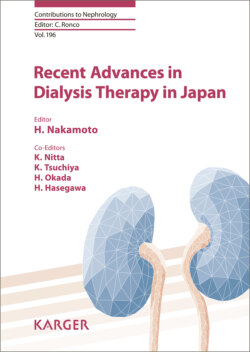Читать книгу Recent Advances in Dialysis Therapy in Japan - Группа авторов - Страница 65
На сайте Литреса книга снята с продажи.
Relationship between Brain Atrophy and Cognitive Function in CKD Patients
ОглавлениеFew reports are available regarding the relationship between brain atrophy and cognitive function. We performed brain MRI as well as conducting the trail making test (TMT) on non-dialysis-dependent CKD patients. The TMT aims to detect any decline in executive function due to frontal lobe dysfunction and yields 3 measures: TMT-A, TMT-B, and ΔTMT. The TMT-A test uses a dedicated form on which numbers from 1 to 25 are randomly located and measures the amount of time required for subjects to draw a line to connect the numbers in numerical orders. The TMT-B test uses a form on which numbers from 1 to 13 and Japanese kana characters from “a” to “shi” are randomly located and measures the amount of time required for subjects to draw a line to connect the numbers (in ascending order) and the kana characters (in the Japanese syllabary order) alternately. Finally, ΔTMT is defined as the difference between TMT-B and TMT-A. We performed the TMT on 95 patients and found that TMT-A, TMT-B and ΔTMT all showed significant inverse correlations with GMR. This significance was maintained after adjustment for confounding factors, such as age, sex, diabetes, eGFR, educational level, systolic blood pressure, smoking/drinking habits, hemoglobin level, history of cardiovascular disease, and urinary protein excretion (Table 1) [4].
Fig. 1. Severe brain atrophy in hemodialysis patients compared to healthy individuals. a Planimetric outline of the ventricles and brain drawn onto the National Institutes of Health images. To obtain the ventricular brain ratio (VBR), cross-sectional area of the lateral ventricle (V) is divided by the brain cross-sectional area (B). b VBR size of hemodialysis (HD) patients and controls according to age decades. AII mean VBR values are higher in HD patients than controls (Student’s test, p < 0.05). Reproduced from [1].
We then divided the brain into four regions, i.e. the frontal, temporal, parietal, and occipital lobes, and examined whether GMR correlated with TMT-A, TMT-B, and/or ΔTMT in each of these regions. Interestingly, significant inverse correlations were observed after multivariable adjustment in the frontal and temporal lobes, but not in the parietal and occipital lobes. These findings suggested that atrophy of the frontal and temporal lobes affects frontal lobe function (i.e., executive function), which was consistent with our hypothesis.
Fig. 2. Inverse association of gray matter volume ratio (GMR), but not white matter volume ratio (WMR), with age. The association of the GMR and WMR with age in peritoneal dialysis (PD) (closed circles; n = 62) and non-dialysis-dependent chronic kidney disease (NDD-CKD) patients (open circles; n = 69) is shown. Gray matter volume (GMV) and the GMR, but not white matter volume (WMV) and the WMR, are inversely associated with age in PD and NDD-CKD patients. Reproduced from [2].
Fig. 3. Comparison of the annual change in gray matter volume ratio (GMR) between peritoneal dialysis (PD, closed circles) and non-dialysis-dependent chronic kidney disease (NDD-CKD, open circles) patients. The annual change in GMR as determined by subtraction of the baseline GMR from the GMR after 2 years, is significantly higher in PD patients than in NDD-CKD patients. Data are least square mean ± standard error. Reproduced from [2].
Table 1. Univariable and multivariable-adjusted regression analyses of correlation between whole-brain GMR and TMT scores in all participants. Reproduced from [4]
Fig. 4. Effect of anemia correction on cognitive impairment evaluated by P300 latency. In 15 patients undergoing chronic hemodialysis, after the start of recombinant human erythropoietin (rHuEPO) therapy (4.7 ± 1.2 months), P300 peak latency significantly decreased as anemia was corrected (hematocrit, 22.7 → 30.6%). Reproduced from [10].
